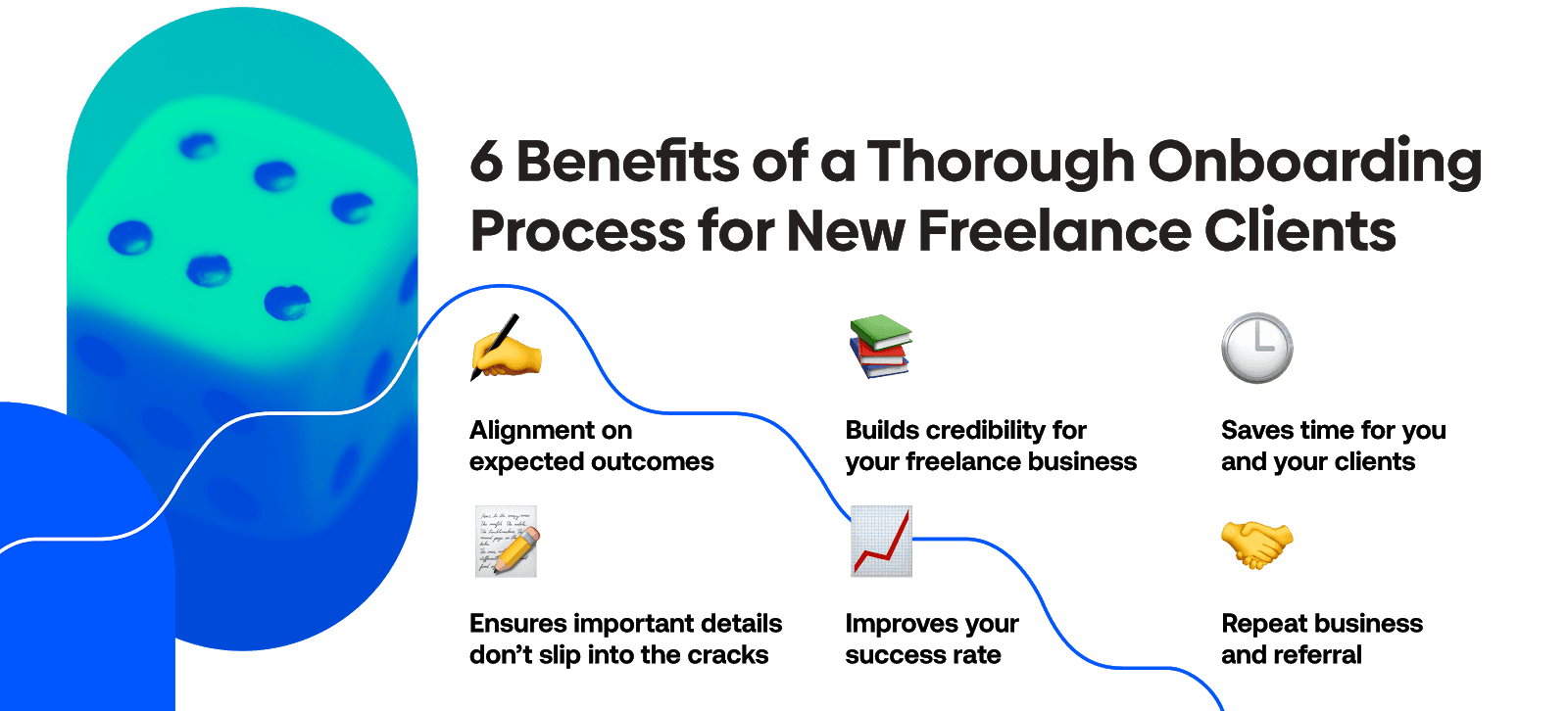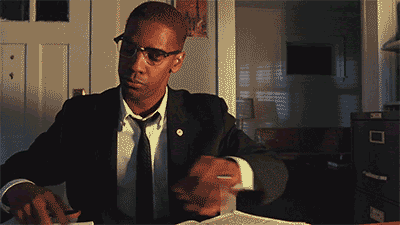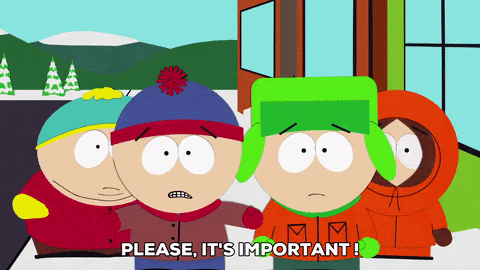New Client Onboarding for Freelancers: 24 Questions Freelancers Should Ask Clients

Landing a new client is the bee’s knees, even more so if it’s your first.
That butterfly feeling you get? The best in the world.
But if you get ahead of yourself and jump into the client's work before onboarding them, it could mean lots of time, moolah, and experience down the drain in the long run 🚽 (Scary, but true!)
Believe it or not, an onboarding process is the difference that makes a difference.
And we're willing to bet that your career idols, pro freelancers, whatever you call them that you crush on are putting this "not-so-secret" weapon to good use.
Don't be a noob. Do freelance like a boss who knows what the h*** they're doing.
Let us show you the way to freelance riches as we explore the questions that make up an effective onboarding process.
We're gonna start by explaining more about what is client onboarding.
Boring, we know. But totes necessary. Trust us 😉
What is Client Onboarding?
Client onboarding isn't some brand new concept 🧙♂️
If you’ve ever worked before (we’re assuming you have…), you’ve probably already gone through one.
Client onboarding is the process of giving a client a rundown of how your freelance business works and all you need to get the project over the finish line🏅
It ensures the following for both parties:
🤝🏽 Provides a clear sense of work styles and what to expect
📃 Spells out exactly what you need from the client to execute the project successfully
✅ Clarifies deliverables
📞 Outlines communication channels

Basically, the client can't just nod yes to you one minute only to come breathing down your neck a month later saying that they didn't know you were gonna do XYZ in this way or the other, threatening to fire you for it.
Mind you, them doing so could also be a breach of contract. (Uhmm, we're assuming you've at least signed a contract with them. If not.... yikes.)
Anyways, what we're trying to say is: Just do the work!
Set up a new client onboarding process to start and end things on the right foot, allowing for smooth sailing throughout the project.
End of story.
Why is a Client Onboarding Process Essential?
In case we didn’t get our very clear point across in the last section, first impressions are everything.
With an onboarding process, you put your best foot forward and deliver an awesome customer experience to clients.
Remember, slick customer experience = repeat business and referrals 🤑
On the other hand, a ramshackle process means you end up with little or no leads, or clients who bounce after the first project.
Here are six benefits of setting up a client onboarding process in your freelance business:

Benefit 1: Clarify and Align on Expectations
The onboarding process ensures your new client knows what to expect from you and your team (if you have one already).
It also spells out what they need to share with you.
Basically, here’s what you and the client should agree on post-onboarding:
💻 Your skillset and the value you bring to the table
📆 Project timelines
👥 The client's involvement in the project
🙌 The expected outcome at the end of the project
The point of doing this is to sync up with your client in advance so you prevent disputes and surprises later on down the road.
Benefit 2: Educate the Client
As a freelancer, remember the client sees you as a subject matter expert (SME).
This means that aside from setting expectations, your onboarding process should provide constructive feedback in addition to recommendations on how best to get crackin’ on the project.
Your process should educate the client on:
📑 Benchmarks of a successful project
ℹ️ Your work process
📊 How you measure success
🗃️ Past projects and clients
Your client should leave the onboarding process feeling pumped and confident.
Benefit 3: Save Time for Both Parties
That feeling when you find out you don’t have everything you need to get the job done when you’re HALFWAY through

And you end up with a bout of typerrhea as you and the client play inbox tetris to round up missing information. 😫
And if that’s not bad enough for ya, if you’re a new freelancer on the client’s portfolio, he or she may have been unsure of your skills to begin with.🙄🤦🏽♀️
Just create a process that ensures you get all you need from the client before you ever touch the work, saving both parties time and possible trust issues.
What’s more, having an onboarding process lets you hit the ground running with the next client. Take it from us. You’ll be happy you did.
Benefit 4: Ensure Nothing is Forgotten
Another wonderful perk of freelancing?
Handling a variety of clients, deadlines, and industries can be STRESS-FULL 😵
Without an onboarding process that sets out deliverables, you could drop the ball on deadlines, or have important details slip between the cracks.
Plus, if the client keeps on throwing in new work to do, you’ll be better able to handle it all!
So, tell us: How do you like them apples? 🍎🍏
Served with a side of organization, we hope 🥧
If you’re not convinced by now that a new client onboarding process is more important than those limited edition shoes you got your eyes on 👟👀, here are two last points to try and sway your opinion.
Benefit 5: Improve Your Success Rate
The experts over at the Project Management Institute (PMI) say:
“Incomplete information is a primary reason for project overrun or failure. Your client onboarding process is a vital element of your information gathering process.”
In other words, not doing your fair share and NOT being nosy AF (yes, YOU get to ask all the questions here) to get all those details will be the reason why you fail.
Don't say we didn't warn you 🤷🏽♀️
The onboarding process helps with the nuts-and-bolts of your clients’ expectations.
Plus, it’s easier for you to measure success when you know what your client needs. #justsayin’
Benefit 6: Finally, Build a Trustworthy Client Relationship
Wrapping things up, creating a standardized onboarding system is the easiest way to ensure that your clients will be wowed 🤩 - from start to finish.
What's in it for you? Being seen as a professional and accountable freelancer they can trust to get ish done.
Plus, happy clients could lead to a steady stream of referrals, or even ongoing work - like we mentioned before. (Gosh, we repeat ourselves SO often just to make sure you understand. THAT’S how much we want you to succeed!)
In short, you scratch their back. They'll scratch yours 😁
Enough said.Now, let's get to the why you really came here today
24 Key Questions to Ask When Onboarding A New Client (As A Freelancer)

A working onboarding process guarantees a seamless (not perfect 😜) working relationship between you and clients.
To set up one, ask yourself the following questions in no particular order:
1. What are the deliverables of the project?
Your onboarding process needs to define the client's expectations and what they are trying to achieve.
For example, maybe the client wants 100 subscribers to their monthly newsletter from the 5 blogs you’ll write, or 200 leads in two weeks for the new landing page you’re scribbling copy for.
By knowing the end goal, you’ll not only have the big picture in mind, but also know exactly what everyone is working toward.
2. Are these expectations realistic?
Remember, you are the SME here.
Sometimes clients approach a freelancer with unrealistic expectations, or they don't understand the problem they are trying to solve and need pointers.
For example, a client who’s a noob to running digital marketing campaigns will need guidance on the average cost-per-click (CPC) when figuring out their ad budgets 💵
Because of their inexperience, they may lowball their ad budgets and then try to pass the blame on you when results aren’t looking promising.
As the SME, it’s your responsibility to keep things realistic. Although it may be uncomfortable to confront the client, trust us. It’s for the best.
3. What are the timelines for the project?
You need to determine how long the project will last and if you have the bandwidth to execute it without fail. Also, watch out for unrealistic timelines.
Though tempting to pull a Speedy Gonzales, doing so could throw off your freelancing cadence - a.k.a. your groove.
Give yourself ample time for research, execution, revisions, and all that jazz.
(Yes, even if you just turn in a first draft, you want to give it your best effort!)
And if the client has steep timelines, set your rates in the same fashion 😉
4. Does the client have a hard deadline, or are they flexible?
Find out if you'll have any wiggle room.
This can uncover details that affect any agreed upon deadlines.
For example, if you are building a website for the client, you might discover that they were hoping to demo the website at a pitch that happens a week before the project deadline.
This means you’d have to finish the wireframe before that pitch - obviously.
It’s all in the deadlines.
5. Has the client worked with a freelancer before?
The ideal answer here should be yes.
It can be time-consuming onboarding a client who's never worked with freelancers. But if that’s the case, set boundaries early.
6. Does the client have a fixed budget for this project?
In a perfect world, you’d send your rates over to the client and then hear the following: “I’ll pay you whatever you want because I know you’re that amazing. Just do your thing” 😍💰
Sadly, in our very real world, compromise is the name of the game, and you should be open to it.
In general, it’s a good freelance skill to set the tone when it comes to money, especially when you have a clear sense of the client's expectations.
And if you meet a client who loves a good haggle, pricing tactics such as “price anchoring” or “disassembling” can help make the situation a little less distressing.
You’re welcome.
7. Who will be my project manager?
The project manager is the client’s rep you’ll be communicating with throughout the project to make sure things are going smoothly.
In some cases, the client might be the project manager. Seeing you’ll be spending a lot of time with this individual (like it or not), you’ll need to check if working styles match by asking the following questions:
📞 Do they have a preferred communication channel?
📆 How available are they?
❓ If you come across problems, how will they respond?
🚅 How fast will they respond?
Keep in mind your project manager’s working style is influenced by one of two things: past experience with freelancers and pressures they are facing.
To make things smooth as a 👶🏽's bottom, make sure you document the scope of work and seek clarity on expected outcomes.
8. How many people client-side will be actively involved in the project?
If your work has to be approved by multiple stakeholders, your project could take longer than planned.
Consider this scenario: You are knocking out final touches on a landing page for the client’s new website. But minutes before it goes live, you realize the project manager needed to sign-off… then the marketing team lead... and finally the VP of marketing.

Will your page go live on time? Or, will it take another week, costing the client precious time ⏳ and money 💸?
Stay tuned for next week’s episode of “Freelancers Who Don’t Use Onboarding Processes” 😂
9. If multiple stakeholders are involved, who gives final approval?
Likewise, to reduce the risks from too many chefs in the kitchen, find out who gives final approval or who owns the project's outcomes.
Then, set up a formalized project approval process that sets specific due dates for approvals.
And make sure to sign a contract outlining all these things before you get going.
That way, no one is confused about due dates, milestones, and objectives.
Plus, your project doesn’t turn into a power struggle between senior members of the client’s team 🥊
10. Does the client have an onboarding process I need to complete?
It's not unusual that clients have an onboarding process.
If so, make sure you ask, and start ticking off anything expected of you. (Again, we wouldn't want any surprises as you're about to kick things off.)
This could include signing a contract, billing, or passing along any details they need to set you up on their invoicing system.
Use this as an opportunity to optimize your own onboarding process. If there are any items on the clients' process that you find helpful, add them to your list.
Work smarter, not harder 😜
11. What do you need from the client?
This is the point where you gather all the info needed to complete the project.
For example, if you are a graphic designer working on a client’s brochure, you’ll need design elements such as the logo, font style, moodboard, and product photography or access to their stock photos account.
Here, you also find out about the clients' products or services, their competitors, and why they outsourced the task to begin with.
🔥 Hot tip: Upsell on any missing information!
For instance, if you're a content strategist and writer hired to write a few blogs, and you realize your client doesn't have their buyer personas created, offer to do it for them.
Since they're already entrusting you with the blogs, they may be more willing to allow you to handle the research side of things as well.
(Granted they like you and your work, that is 😉)
12. Does the client need anything from you?
The onboarding process is a two-way street.
So, find out if the client needs any support from you. Again, we’re gonna drop an example here for you because we want you to understand this all! (Out with the vague 📤, in with the details 📥)
Imagine that you need data from Google Analytics (a web service offered by Google that tracks and reports on web traffic), and the client’s marketing team doesn’t have an account.
It’s up to you to make sure you provide the proper training for them or point the marketing team in the direction of someone who can.
13. Do you or the client have any non-negotiables?
Are there any parts of your work processes that are non-negotiable? These would be things such as:
💲 “I require a 50% deposit up front.”
📱 “I prefer phone calls to email.”
🏢 “My “office hours” are 10:00 AM - 3:00 PM.”
If so, let the client know right away.
Next, find out if your client also has any non-negotiables before you start the project
Again, two-way street here, people.
If the client pays upon completion, and you were expecting a deposit, that would kind of be important to know… 😳
14. Is there anything else I should know?
Here you give the client the opportunity to share anything your previous sections might have missed.
It’s also a smart way to give them a sense of control over the process.
Clients usually see this as an opportunity to share any frustrations they’ve had with freelancers in the past.
And this is your VERY OBVIOUS cue for not falling into the same traps they did, for Pete's sake 🙄
15. Is this the first time the client is executing this project?
If it’s the first time, you are operating from a blank slate. If it isn't, you should find out what happened the last time.
Was it successful? If it wasn't, why was it termed a failure?
Did the client run a project post-mortem (a.k.a. a process to determine why the project was successful or unsuccessful)?
Are they approaching it differently this time around?
16. How do you prefer I reach you?
This is dependent on you, but don’t sleep on your communication channels.

Consistent communication is key to staying in sync with your client and task management.
Some clients prefer instant messaging platforms, such as Slack, and others will prefer snail mail 📫 (OK, maybe not that, but you get the point.)
If the client can message you around the clock, it allows for faster response times 📨
17. How often do you expect me to be available?
Similarly, not every client is comfortable with asynchronous communication, but that doesn't mean they should expect you to be available 24/7.
Use this section to set your boundaries 🚪
18. Can I work on other projects while working with you?
Some clients want an exclusive agreement while working on their projects.
This could happen if you are going to be handling sensitive information.
While this could mean reduced cashflow, it could also lead to an ongoing retainer if they enjoy working with you.
Look at the bright side of things 🌞
19. Do I need to sign a non-disclosure agreement (NDA)?
Also, find out if you need to sign an NDA.
It’s often necessary in industries such as software development; creative fields (content, graphic, media); and consulting.
Don’t get sued for sharing confidential stuff.
Yes, we're being Debbie Downers here. But we're just looking out for your best interest 😊
20. Can I use this project in my portfolio?
Again, ask this question if you are told to sign an NDA.
Some clients prefer to keep it confidential that they used a freelancer for specific projects.
If that's the case, consider increasing your rates as that means you lose a sample for your portfolio.
21. Are there any non-compete clauses I should know about?
In industries, such as technology, or if you’ll be working on a new project, the client might have you sign a non-compete clause.
These sort of agreements prevent you from working with the client’s competitors.
Good thing is, they aren’t common in the freelance world.
Look, it’s OK to sign these sort of clauses, but before doing so, make sure it doesn’t affect your future freelance business.
⚠ Fair warning: If you break these agreements, you could wind up in court.
And you wouldn’t want that, would you?
22. Do you have a preferred payment method?
PayPal has sort of become the go-to payment method for many clients and freelancers.
However, different electronic funds transfers (EFTs), such as Transferwise or WorldRemit, are also widely used.
In our increasingly global world, it's best if you accept more than one payment method, especially since international transfers are definitely a thing.
You don’t wanna lose out on a client because of payment issues. #rookiemistake
23. Do I get an upfront payment?
Unless it's a project with a retainer fee, you shouldn't start work without advance payment.
Wondering why?
It’s an easy way to weed out shady clients. Plus, when a client pays a deposit, they are more likely to take the project seriously.
It's up to you to decide your preferred split.
It could be 50% at the start and the balance at the end. Or, you agree on check-ins, where you get paid once deliverables are ticked off.
24. Finally, how do I add value?
This should be running through your mind.
Ask yourself how best you can deliver value for the client considering all you know now.
What business objectives will be affected by the project's outcomes? How do you ensure that overall results are overwhelmingly positive?
Nail this, and the returns will be far and wide 🤑
Ready, Set, Create Your Client Onboarding Process 🚀
In case you couldn’t tell by now, creating your client onboarding process isn't something that takes the back burner.
It’s a process that:
🔧 Builds reputable and profitable relationships with your client(s)
⏩ Drives exponential growth for your freelance business
🤗 And promotes excellent customer experience
Most importantly, all parties come out happy 😁
Do your client onboarding questions right, and you can kiss the majority of your freelancing woes - and headaches - goodbye 💋
If you would rather spend time working than doing boring business stuff, get early access to Boost, the all-in-one business tool that makes it easier for everyone to build a meaningful business 🦸♀️️
